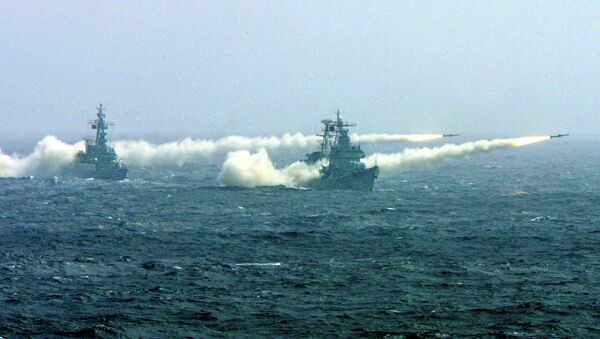Sputnik discussed the large-scale military drills in the South China Sea with Dr. Collin Koh Swee Lean, Research Fellow at the Maritime Security Program, part of the Institute of Defense and Strategic Studies at Nanyang Technological University.
Sputnik: What’s your thoughts on the timing of these drills, why is it happening at a time when US is conducting its own drills?
Dr. Collin Koh Swee Lean: If you look at what happened in more recent months you'll find that actually there's some speculation as to the motive of the drills in South China Sea, some attribute them to the trade war and I think there's several strategic factors that led to the drills, one is to do with the more recent domestic political developments in China where we see president Xi Jinping exerting his authority over the military. So one of the factors behind the spate of drills, not just the current drills but also the previous marine drills and last year air force exercises as well directed at the domestic audience, second it has to do with the rising speed of developments in the South China Sea, for example the US navy activities and also activities conducted by other regional powers like Japan or Australia for the matter, so I think we're seeing actually a whole group of factors, I don’t think there's one specific motivating factor behind the drill.
READ MORE: US, China Flex Naval Muscles Amid Ongoing Trade War
Sputnik: So what about the scale of the event, you've mentioned the rationale behind this, but is this an overall general flexing of China's muscle or is it directed at a specific country?
Dr. Collin Koh Swee Lean: The thing is that we talk about the scale, if you compare with the past, I think one of the very interesting observations is that the scale of the more recent navy drills that we've seen with around 40 something vessels, these boat don't just come from the East Sea which is basically responsible South China Sea. What we are seeing here basically a combination of fleets from the north and the south, in terms of the scale it's pretty unusual I would say, but I think this is not unexpected in a sense that we saw a gradual build-up in terms of the scale of those drills and in more recent years we are only seeing that these drills become larger, and more frequent, and the intensity of these drills they are being conducted over a certain period of time, but when it comes to being directed at a certain party most of the commentators will attribute it to the US, for example, but my sense is that it’s certainly not just the US.
I think what China is trying to do is to send a message to anybody who it perceives to be potentially meddling in the South China Sea, so it's not just to the US but also in relation to more recent statements made by other interested powers like those in Europe for example, talking about wanting to preserve the freedom of navigation in the South China Sea.
Dr. Collin Koh Swee Lean: So far what we are seeing that the US is still very keen despite the more recent developments as to its readiness after the whole string of collisions last year, I think there is this desire on the part of the US to demonstrate its security commitment to the region not just in the case of the Korean Peninsula but also to the South China Sea. So what I think we are seeing here is basically a demonstration of resolve on the part of the US, and more recent we are seeing more engagement between the US Navy with various Southeast Asian powers including Vietnam. I think the US demonstrated it with its carrier visit to Da Nang, so I think what we were seeing here is really the US demonstration of its commitment, whether it's going to increase remains to be seen, I think in a way it's also partially influenced by the events on the Korean Peninsula, because if we assume that what is going to happen on the Korean Peninsula is easing of the tensions on the peninsula then potential we will see more US commitment, more US involvement in Southeast Asia and the South China Sea for that matter.
The views and opinions expressed by Collin Koh Swee Lean are those of the scholar and do not necessarily reflect Sputnik's position.




